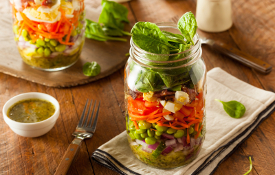Did you know that the American Heart Association recommends eating 4 to 5 servings of fruits and vegetables each day? Research continues to indicate that fruit and vegetable consumption is imperative to good health, the prevention of disease, and the treatment of many chronic conditions. The 2015-2020 Dietary Guidelines state that there is moderate evidence that shows consuming vegetables and fruits every day is associated with a reduced risk of cardiovascular disease.
Fruits and vegetables can also help with weight management, reducing blood pressure, controlling blood glucose, and preventing some cancers. So any way you slice it, fruits and vegetables work together to promote good health.
How can you begin to estimate your current intake? On a daily basis, begin writing down what you eat. Note any vegetables or fruits that might be hidden, such as vegetables in marina sauce or soup, or fruit in your cereal or yogurt. A typical serving of fruit or vegetable can usually fit in the palm of your hand. Simple serving size reminders include:
- ½ cup of cut up fruit or vegetables
- ½ cup of cooked beans (black, kidney, pinto) or peas
- 1 cup of raw salad greens (romaine, spinach or arugula)
- 1 medium size piece of fruit (apple, orange)
- 1 small banana
- ¼ cup dried fruit (raisins, cranberries or prunes)
- ¾ cup or 6 ounces of 100% fruit or vegetable juice
After recording your intake for a week, review your daily totals of fruits and vegetables. Use these numbers as a guide or baseline of what you are consuming on average and then begin to build on your current intake.
How can you get more out of your fruit and vegetable intake?
- Add vegetables to all of your meals and experiment with vegetables as the main course. Read labels to ensure that your serving of fruits and/or vegetables count towards a healthy diet by containing the most vitamins, nutrients, and fiber in each serving. If the label indicates added sugar, salt, or less than 1 gram of fiber per serving, it might not be the best fruit or vegetable choice.
- Choose foods that increase your nutritional intake, including vegetables with more potassium (sweet potatoes, white potatoes, white beans, tomato products, beets, greens, soybeans, lima beans, winter squash, spinach, lentils, and kidney beans).
- Select foods with less sodium, and make your own seasonings or sauces to reduce the added salt. Try preparing more foods from fresh ingredients to lower sodium intake. Most sodium in peoples’ diets comes from packaged or processed foods.
- Choose a serving of fruit that does not have added sugar, such as fresh fruit, frozen fruit without additives, and canned fruit in its own juices. Avoid items that contain added sugar (not naturally occurring in the food or beverage), including fruit juices, bottled smoothies, sports drinks, or 'fruit' based snacks (fruit roll-ups or gummies).
- Start by adding one more serving of a fruit or vegetable each day for a few weeks. Then gradually continue to incorporate more into your diet.

Healthy 'Green' Wrap
Makes 6 servings
Ingredients:
- 24 spears asparagus
- 1 ripe avocado, pitted and peeled
- 1 tablespoon lime juice
- 1 clove garlic, minced
- 1 1/2 cups cooked cold long-grain white rice
- 3 tablespoons plain nonfat yogurt
- 3 whole wheat tortillas, 10 inches in diameter
- 1/3 cup fresh cilantro leaves
- 2 tablespoons chopped red onion
Directions:
- In a medium-sized saucepan over high heat, bring 2 inches water to a boil. Place the asparagus in a steamer basket, cover, and steam until just tender (approximately 5 minutes). Remove the asparagus and immediately rinse in cold water to stop the cooking process. Drain thoroughly.
- In a small bowl, mash the avocado, lime juice, and garlic into a coarse puree.
- In another small bowl, stir together the rice and yogurt. Mix well.
- Heat a large dry frying pan (not one with a nonstick surface) over medium heat. One at a time, heat the tortillas in the hot pan until softened (approximately 20 seconds per side).
- Lay the tortillas flat on a clean work surface. Spread the avocado mixture equally among the tortillas. Top each with an equal amount of the rice mixture, asparagus spears, cilantro, and onion.
- Fold each tortilla, bringing both sides in and the bottom up over the filling; then roll to close.
- Serve at room temperature.
- Can prepare ahead of time. Refrigerate after preparation.
- To serve, cut each wrap in half crosswise.
Updated: 10/15/19

